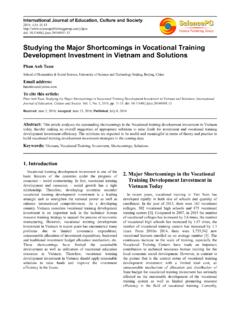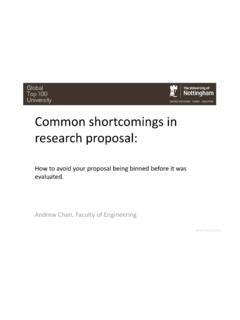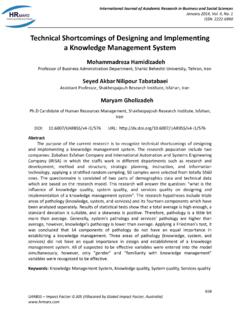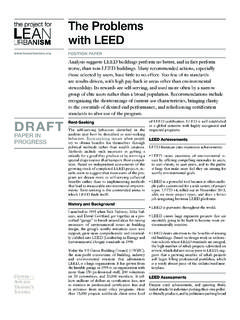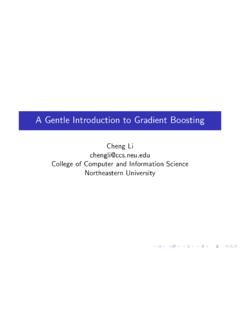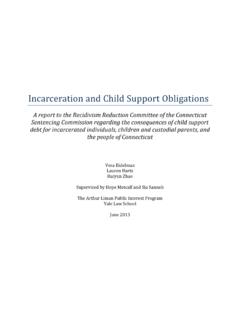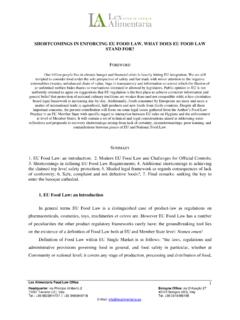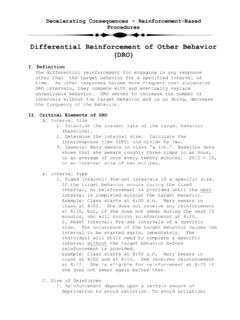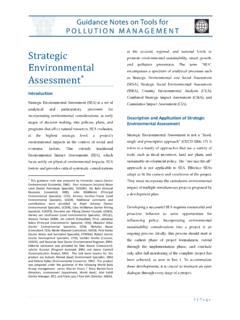Transcription of the effects of industry classification changes on us ...
1 The effects of industry classification changes onus employment composition Teresa C. Fort Tuck School of Business, Dartmouth CollegeShawn D. Klimek Center for Economic Studies, US Census BureauPreliminary Draft Comments WelcomeThis Version: March 2016 AbstractThis paper documents the extent to which compositional changes in US employment from1976 to 2009 are due to changes in the industry classification scheme used to categorize eco-nomic activity. In 1997, US statistical agencies began implementation of a change from theStandard Industrial classification System (SIC) to the North American Industrial ClassificationSystem (NAICS). NAICS was designed to provide a consistent classification scheme that consol-idated declining or obsolete industries and added categories for new industries.
2 Under NAICS,many activities previously classified as Manufacturing, Wholesale Trade, or Retail Trade werere-classified into the Services sector. This re- classification resulted in a significant shift of mea-sured activities across sectors without any change in underlying economic activity. Using anewly developed establishment-level database of employment activity that is consistently clas-sified on a NAICS basis, this paper shows that the change from SIC to NAICS increased theshare of Services employment by approximately 36 percent. percent of US manufacturingemployment, equal to approximately million jobs, was reclassified to services. Retail tradeand wholesale trade also experienced a significant reclassification of activities in the codes:E24 Comments are welcome.
3 Any opinions and conclusions expressed herein are those of the authors and do notnecessarily represent the views of the US Census Bureau. All results have been reviewed to ensure that no confidentialinformation is disclosed. We thank Linh Vu for excellent research assistance. 100 Tuck Hall, Hanover, NH 03755, USA,tel:+1 603 646 employment Composition1 IntroductionIndustrial classification systems are critical for obtaining accurate measures of economic provide information about the types of goods and services produced in an economy, the kindsof jobs available, and countries comparative advantage. industry classification systems also play animportant role in economic research. They are used across all fields to restrict a study to a specifictype of activity ( , manufacturing), to analyze the industrial composition of a sample, to provideappropriate controls, and even to construct sources of exogenous classification systems are also essential for analyzing how economic activity haschanged over time.
4 In order to produce reliable time series information, however, the classifica-tion system itself must be consistent across time. This need for consistency poses a significanthurdle to analyzing economic change , since economies naturally evolve, with some industries be-coming obsolete and the need for new categories arising. Statistical agencies face a tradeoff betweenmaintaining the same system to facilitate time series analysis and updating the existing system toensure the most accurate depiction of activity at a particular point in time. In 1997, US statisti-cal agencies transitioned from using the Standard Industrial classification System (SIC) to usingthe North American classification System (NAICS). NAICS was implemented to provide a con-sistent classification methodology across different industries, to facilitate comparisons across theUS, Canada, and Mexico, and to introduce new flexibility so that revisions could be made to thesystem as the economy grows and evolves.
5 While the transition from SIC to NAICS helps addressthe challenges of clearly and correctly classifying economic activity in an evolving economy, it alsoposes new challenges. In particular, it makes it difficult to conduct any time series analysis thatrelies on industry classifications and that spans years prior and post paper has two main goals. First, it provides an accurate and consistent measure of thecomposition of US economic activity from 1976 to 2009. We find that the transition from SIC toNAICS led to significant reclassification of activity from manufacturing and wholesale into othersectors, particularly services. A naive analysis of the changes in US employment composition overthis period would overstate the rise in services employment by approximately 36 percentage pointsand overstate the fall in manufacturing employment by almost 11 percentage points.
6 A second goalof the paper is to illustrate potential sources of bias that may arise in economic research that spansthis time period and relies on industry classifications. We therefore identify key distinctions betweenSIC and NAICS and discuss how ignoring them may bias existing example, Rajan and Zingales (1998); Autor et al. (2013); Pierce and Schott (2015)all use industry -levelinformation as a source of exogenous variation to identify a causal is challenging to conduct a times series analyses with any industry component whenever the classificationsystem changes . SIC underwent revisions in 1972, 1977, and 1987. The transition from SIC to NAICS involvedreclassifying a significantly larger share of activity, and the affected activity was more likely to be classified not justin different industries, but also in different employment CompositionThe Standard Industrial classification (SIC) system was first implemented in the US in the1930s.
7 Although it was updated numerous times, by the 1990s the SIC system faced several im-portant limitations. First, it did not provide adequate categories new types of activities, especiallythose in services. Second, it classified activity based on a number of different concepts, includingboth production and demand-based definitions. According to Triplett et al. (1995), by the 1990sthe SIC system was sufficiently heterogeneous in its classification of economic activity that it wasnecessary to qualify interpretations of results from research based on the SIC system, especiallycross-sectional and time-series studies making inter- industry comparisons. Third, it was not easilycomparable to international classification systems. In 1997, after years of discussion and analysis,US statistical agencies addressed these issues by replacing SIC with the new SIC, all industry categories in NAICS are based on production concepts.
8 In other words,establishments are classified into industries based on the activities performed at the establishment,rather than as a function of the products they sell or the customers they serve. The NAICS production-process methodology was chosen to provide consistency across different industries, aswell as to facilitate comparisons across the US, Canada, and Mexico. In addition, NAICS wasdesigned to be flexible so that revisions could be made to the system as the economy grows analyze the transition from SIC to NAICS using data from the US Census Bureau s Longi-tudinal Business Database (LBD) from 1977 to 2009. The LBD has information on every private,non-farm establishment in the US. We address the transition from SIC to NAICS by developinga new methodology that exploits the time series and establishment nature of the LBD to assigna consistent NAICS 2002 industry code to every establishment in the LBD.
9 Using this consistentclassification across the entire time period, we can calculate more accurate measures of the changesin US employment composition over time. Our methodology allows for differences in the evolutionof economic activity at the establishment main contribution of the paper is to develop and implement a new methodology that assignsa consistent industry code to all establishments in the LBD. These codes allow us to calculatethe extent to which the transition from SIC to NAICS changed the sectoral composition of USemployment, both in the aggregate and at finer levels of aggregation. Although statistical agenciesand researchers have been careful to address the potential biases that might arise from the transition,their efforts have been limited to using aggregate concordances.
10 Our approach exploits the timeseries and establishment-level features of the LBD to reduce the need for random assignments and toallow for industry mappings to vary by establishment size. Because every establishment is assigneda NAICS code, it is possible to exploit industry variation across geography and across the firmsize distribution. This flexibility is important since researchers identification strategies often relyon geographic variation, or since specific mechanisms may have very heterogeneous effects across2US employment Compositiondifferent paper also contributes to two important literatures. First, it provides a new perspectiveon a recent literature that examines the decline of US manufacturing employment . A number ofpapers have studied this decline and attributed a significant portion of it to increased competitionfrom Chinese imports ( , Acemoglu et al.)

